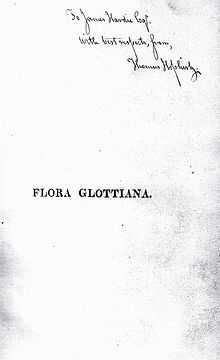Thomas Hopkirk
Thomas Hopkirk (1785–1841) was a Scottish botanist and lithographer.
The Hopkirks
He was descended from a gentry family who came from Hopekirk, near Hawick, by way of Dalkeith in Midlothian,to Dalbeth in Glasgow . His grandfather, also Thomas (1716–1781 ) had been a wealthy Glasgow merchant - a “Tobacco Lord” or “Virginia Don” - who had diversified into coal mining, brewing and banking. He had lived originally in a tenement in the High Street of Glasgow, called “Hopkirk’s Land”. David Dale rented the shop premises on the ground floor, where he operated as the first Glasgow agent of the Royal Bank of Scotland. Thomas then moved to a fine house at the corner of Argyle Street and Dunlop Street, which became the Buck’s Head Hotel. (This was demolished in 1865; the later department store still displays the Buck on its roof.)
James Hopkirk (1749 - 1838), Thomas's father

Thomas's education and first publication

He amassed an extensive collection in his garden in Dalbeth, of which he published a full list. He became a Justice of the Peace for Lanarkshire and was elected a Fellow of the Linnean Society in 1812 .
Royal Botanic Institution of Glasgow
In 1816 he joined with others to form a society, later including William Jackson Hooker, Regius Professor of Botany at Glasgow University, with the intention of displaying botanical specimens, including his Dalbeth collection. About 8 acres (32,000 m2) of land were laid out in 1817 at Sandyford, near Sauchiehall Street, Glasgow. In 1817, the Royal Botanic Institution of Glasgow was formed by Royal Charter and the Glasgow Botanic Gardens set up. As the City expanded westwards, the gardens had to move and in 1842, they were opened by the banks of the River Kelvin in the west-end of the city, where they remain to this day.
Flora Anomoia and Darwin
In 1817 he published Flora Anomoia - a general view of the anomalies in the vegetable kingdom, describing "the anomalies which take place amongst vegetables. It lists the variations under Anomalies of the Root, Stem and Branches, Leaf, and Flower. He notes such unusual developments as an oblong turnip, the different kinds of Holly leaf, a bluebell with twenty stamens, and so on. Lithographic illustrations were by his co-worker James Hardie.
He was known to Charles Darwin, who quoted from Hopkirk's publications in his The Variation of Animals and Plants under Domestication. (John Murray, London 1868), especially with regard to Convolvulus tricolor.
Lithography
Partly as a consequence of his botanical publications, he became interested in lithography. He helped prepare the lithographic plates for The Glasgow Looking Glass, of which he became editor in 1825.
Later life and death
Glasgow University made him honorary Doctor of Laws in 1835. In 1837, he published popular gardening book, called The Juvenile Calendar of a Natural History of the Year. He moved to Ireland, where he helped in geological surveys for the Irish Ordnance Survey. He presumably married there, but we know little about his wife, who died before him, or their daughter. He died in Belfast on the 24th of August 1841 and is buried there in Clifton Cemetery.
Glasgow University named the Hopkirk Laboratory for taxonomic biology after him. There is also a Hopkirk Building in Glasgow Botanic Gardens.

Bibliography
- Dictionary of National Biography (Oxford, 2004) ISBN 0-19-861395-4
- Hopkirk, Thomas Flora Glottiana; a catalogue of the indigenous plants on the banks of the River Clyde, and in the neighbourhood of the City of Glasgow. 8 vols Glasgow 1813
- Hopkirk, Thomas. (1817) updated by Martin Cragg-Barber in Flora anomoia updated Chippenham : That Plant’s Odd, 1999.
- Mackenzie, Peter. Old Reminiscences of Glasgow. Glasgow, 1890 ii, 33
- Turner, Robert. Thomas Hopkirk of Dalbeth: a sketch of his life and botanical work. Transactions of the Natural History Society of Glasgow. 27 January 1885
- Biographical note on James Hopkirk. By David Murray. In A Statistical Account of the Barony Parish of Glasgow, with the principal transactions of the Heritors for the last forty years, 1827, manuscript by James Hopkirk. Line drawings by unknown artist.
|